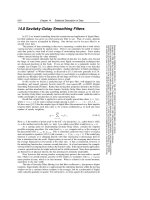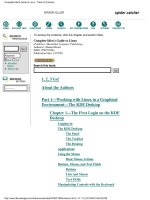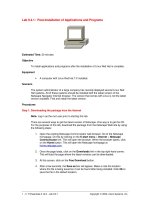Tài liệu COMPLETE TABLE OF CONTENTS AND GLOSSARY ppt
Bạn đang xem bản rút gọn của tài liệu. Xem và tải ngay bản đầy đủ của tài liệu tại đây (243.77 KB, 13 trang )
COMPLETE
TABLE OF CONTENTS
AND
GLOSSARY
“License for Use” Information
The following lessons and workbooks are open and publicly available under the following
terms and conditions of ISECOM:
All works in the Hacker Highschool project are provided for non-commercial use with
elementary school students, junior high school students, and high school students whether in a
public institution, private institution, or a part of home-schooling. These materials may not be
reproduced for sale in any form. The provision of any class, course, training, or camp with
these materials for which a fee is charged is expressly forbidden without a license including
college classes, university classes, trade-school classes, summer or computer camps, and
similar. To purchase a license, visit the LICENSE section of the Hacker Highschool web page at
www.hackerhighschool.org/license.
The HHS Project is a learning tool and as with any learning tool, the instruction is the influence
of the instructor and not the tool. ISECOM cannot accept responsibility for how any
information herein is applied or abused.
The HHS Project is an open community effort and if you find value in this project, we do ask
you support us through the purchase of a license, a donation, or sponsorship.
All works copyright ISECOM, 2004.
2
COMPLETE TABLE OF CONTENTS AND GLOSSARY
Table of Contents
Lesson 1: Being a Hacker
1.0 Introduction
1.1 Resources
1.1.1 Books
1.1.2 Magazines and Newspapers
1.1.3 Zines and Blogs
1.1.4 Forums and Mailing Lists
1.1.5 Newsgroups
1.1.6 Websites
1.1.7 Chat
1.1.8 P2P
1.2 Further Lessons
Lesson 2: Basic Commands in Linux and Windows
2.1. Introduction and Objectives
2.2. Requirements and Setup
2.2.1 Requirements
2.2.2 Setup
2.3. System Operation: WINDOWS
2.3.1 How to open an MS-DOS window
2.3.2 Commands and tools (Windows)
2.4. System Operations: Linux
2.4.1 How to open a console window
2.4.2 Commands and tools (Linux)
Lesson 3: Ports and Protocols
3.1 Introduction
3.2 Basic concepts of networks
3.2.1 Devices
3.2.2 Topologies
3.3 TCP/IP model
3.3.1 Introduction
3.3.2 Layers
3.3.2.1 Application
3.3.2.2 Transport
3.3.2.3 Internet
3.3.2.4 Network Access
3.3.3 Protocols
3.3.3.1 Application layer protocols
3.3.3.2 Transport layer Protocols
3.3.3.3 Internet layer Protocols
3.3.4 IP Addresses
3.3.5 Ports
3
COMPLETE TABLE OF CONTENTS AND GLOSSARY
3.3.6 Encapsulation
Lesson 4: Services and Connections
4.0 Introduction
4.1 Services
4.1.1 HTTP and The Web
4.1.2 E-Mail – POP and SMTP
4.1.3 IRC
4.1.4 FTP
4.1.5 Telnet and SSH
4.1.6 DNS
4.1.7 DHCP
4.2 Connections
4.2.1 ISPs
4.2.2 Plain Old Telephone Service
4.2.3 DSL
4.2.4 Cable Modems
Lesson 5: System Identification
5.0 Introduction
5.1 Identifying a Server
5.1.1 Identifying the Owner of a domain
5.1.2 Identifying the IP address of a domain
5.2 Identifying Services
5.2.1 Ping and TraceRoute
5.2.2 Banner Grabbing
5.2.3 Identifying Services from Ports and Protocols
5.3 System Fingerprinting
5.3.1 Scanning Remote Computers
Lesson 6: Malware
6.0 Introduction
6.1 Viruses (Virii)
6.1.1 Introduction
6.1.2 Description
6.1.2.1 Boot Sector Viruses
6.1.2.2 The Executable File Virus
6.1.2.3 The Terminate and Stay Resident (TSR) Virus
6.1.2.4 The Polymorphic Virus
6.1.2.5 The Macro Virus
6.2 Worms
6.2.1 Introduction
6.2.2 Description
6.3 Trojans and Spyware
6.3.1 Introduction
6.3.2 Description
6.4 Rootkits and Backdoors
6.4.1 Introduction
4
COMPLETE TABLE OF CONTENTS AND GLOSSARY
6.4.2 Description
6.5 Logicbombs and Timebombs
6.5.1 Introduction
6.5.2 Description
6.6 Countermeasures
6.6.1 Introduction
6.6.2 Anti-Virus
6.6.3 NIDS
6.6.4 HIDS
6.6.5 Firewalls
6.6.6 Sandboxes
6.7 Good Safety Advice
Lesson 7: Attack Analysis
7.0 Introduction
7.1 Netstat and Host Application Firewalls
7.1.1 Netstat
7.1.2 Firewalls
7.2 Packet Sniffers
7.2.1 Sniffing
7.2.2 Decoding Network Traffic
7.2.3 Sniffing Other Computers
7.2.4 Intrusion Detection Systems
7.3 Honeypots and Honeynets
7.3.1 Types of Honeypots
7.3.2 Building a Honeypot
Lesson 8: Digital Forensics
8.0 Introduction
8.1 Forensic Principals
8.1.0 Introduction
8.1.1 Avoid Contaminiation
8.1.2 Act Methodically
8.1.3 Chain of Evidence
8.1.4 Conclusion
8.2 Stand-alone Forensics
8.2.0 Introduction
8.2.1 Hard Drive and Storage Media Basics
8.2.2 Encryption, Decryption and File Formats
8.2.3 Finding a Needle in a Haystack
8.2.3.1 find
8.2.3.2 grep
8.2.3.3 strings
8.2.3.4 awk
8.2.3.5 The Pipe “|”
8.2.4 Making use of other sources
8.3 Network Forensics
8.3.0 Introduction
8.3.1 Firewall Logs
5
COMPLETE TABLE OF CONTENTS AND GLOSSARY









